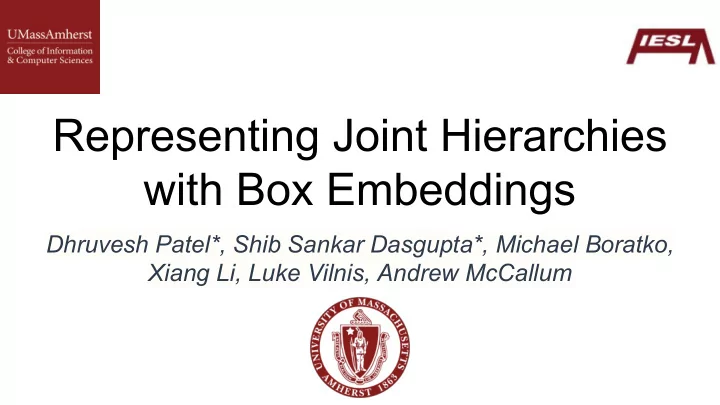

Representing Joint Hierarchies with Box Embeddings Dhruvesh Patel*, Shib Sankar Dasgupta*, Michael Boratko, Xiang Li, Luke Vilnis, Andrew McCallum
Hierarchies and Box Embeddings Mammal Dog Cat Dog Mammal Person Person Cat Woman Woman Hierarchies are composed of transitive and asymmetric relations ➢ Box embeddings can naturally represent such relations using containment ➢
Joint Hierarchies
Joint Hierarchies
Joint Hierarchy in Box Embedding Space Has-Part and Is-A Box for each Entity
Optimization
Optimization
Regularisation Without With regularization ● Using Volume Penalty regularization ○ Penalize when size of box is greater than a fixed volume Regularization loss
Individual Hierarchies: Datasets ● Hypernym graph is more tree like. ● Meronym is less tree like: ○ contains a lot of connected components and ○ nodes with multiple parents.
Individual Hierarchies : Results ● The F1 score of binary classification on the unseen test edges with a fixed set of random negatives. ● The hierarchies are modelled separately.
Joint Hierarchy: Results ● F1 score of binary classification on the test edges of the Joint Hierarchy (all the red edges in the figure) with a fixed set of random negatives.
Conclusion ● We show that the regularized box embeddings can learn to represent a tree-like hierarchical relation graph with far fewer edges from the transitive closure. ● We also show that the box embeddings are not restricted to strictly tree-like structures . ● We propose a method to model multiple hierarchical relations jointly in a single embedding space. ● In all cases, our proposed method outperforms or is at par with all other embedding methods. *Source code and processed data : https://github.com/iesl/Boxes_for_Joint_hierarchy_AKBC_2020
Recommend
More recommend